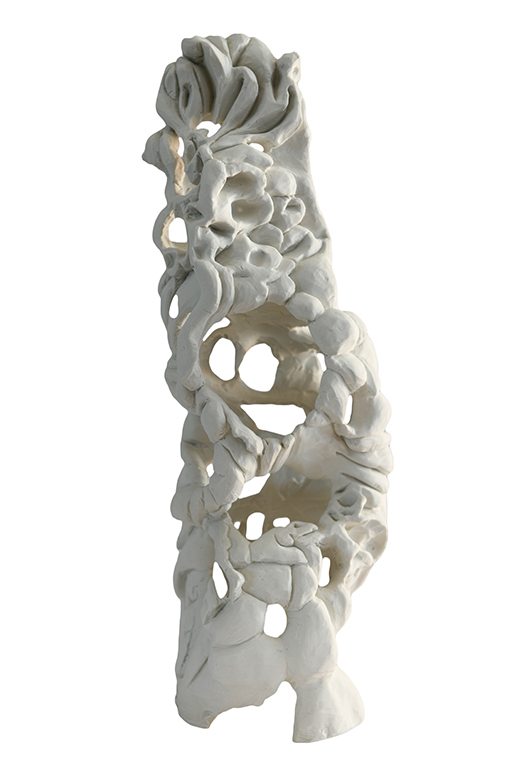Carolin Rechberg moves through art like a traveler collecting textures, sounds, and sensations. Born in Starnberg, Germany, she doesn’t stay long in one place—at least not creatively. Her practice spans ceramics, painting, sculpture, performance, photography, poetry, sound art, textiles, and more. This isn’t eclecticism for its own sake. Rechberg’s work is rooted in process. For her, the act of making carries as much—if not more—meaning than the finished piece. She treats art as a living conversation: one that evolves through her body, her voice, her senses, and her engagement with the material world. Her work doesn’t demand interpretation as much as it invites presence. It wants to be experienced, not explained.

One of Rechberg’s ceramic sculptures, Contemplation Stone XXI (2021), sits at just over 43 cm tall. At first glance, it’s quiet—perhaps even unassuming. But the longer you sit with it, the more it begins to open. It’s a work that seems to breathe. Made from ceramic, its surface holds a tension between form and suggestion. It could be a seed, a weather-worn rock, a memory made solid. Like much of Rechberg’s work, it resists quick definition.
But that’s the point.
Rechberg approaches her sculptures like collaborators. Contemplation Stone XXI isn’t a statement. It’s the result of a relationship—between the artist and the material, the past and the present, the gesture and the stillness. She describes the process behind it as a journey. The sculpture carries its own timeline: the inception of the idea, the shaping of form, the quiet work of hands on clay, the firing, the cooling, the moment it enters the world and begins to interact with others. For her, the sculpture doesn’t become real at the end of the making. It continues becoming in the presence of the viewer.
There’s an energy in this idea—something that echoes through ancient traditions of object-making, where tools, vessels, and totems were created not to be shown, but to be lived with. Rechberg taps into that lineage. Her sculptures aren’t decorative. They feel necessary. They ask you to slow down. They speak in low tones.
Contemplation Stone XXI is part of a series. Each piece carries the same sense of arrival. There’s a humility in the way she names them—stones, not monuments. But they carry weight. They’re records of time, labor, and feeling. They’re also physical responses to her broader practice, which involves performance and voice work. In a way, the stones are the pauses in the conversation. They hold the silence. They mark the space between actions.
Rechberg doesn’t isolate her disciplines. Her sculpture informs her poetry. Her textile work leans into her drawing. Her sound art influences how she approaches ceramics. It’s all connected, all part of the same continuum. The same spirit that shaped Contemplation Stone XXI might show up in a spoken-word piece or a soft sculpture weeks later. She works like nature does—organically, intuitively, in cycles.
This mindset bleeds into how she thinks about completion. She doesn’t see the end of a piece as a stopping point. Instead, she sees it as a shift in relationship. The sculpture, once finished in her hands, begins again in someone else’s. The viewer completes the work through attention, care, and interpretation. The energy she puts into the piece lingers and responds. It’s a generous way of working—and thinking.
Rechberg’s work reminds you that the world isn’t static. Everything is always changing—shaping and being shaped. Her sculptures are not declarations. They’re open questions. They ask you to feel, to wait, to return again later and notice what’s different. You don’t just look at them. You spend time with them.
With Contemplation Stone XXI, she offers a moment of stillness that keeps unfolding. A quiet artifact of process, energy, and encounter. A pause with weight. A presence that listens back.


